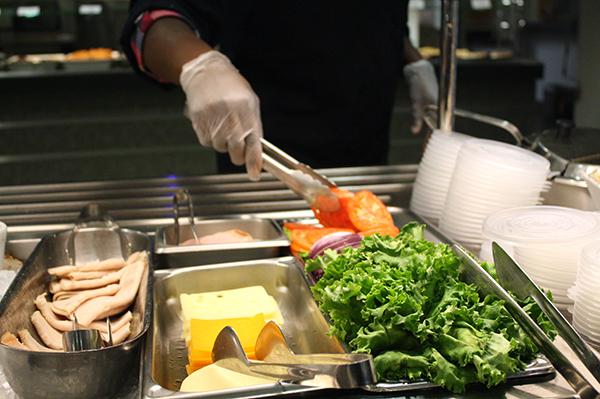Four to five companies applied to be GW’s next food provider, students involved in the process said.
GW has spent the last several months reviewing applications from those companies as its 10-year contract with Sodexo expires, students involved in the preliminary review process said. The other vendors already work at other universities, both in D.C. and outside of the area.
Sodexo – which is the food service provider for dozens of universities, according to its website – also submitted a proposal, the students said. They declined to say which other food provider companies have applied because GW has not completed the selection process.
If GW picks a company other than Sodexo to provide food in dining venues like J Street and Pelham Commons, it would be the first time a different company ran those venues in the last 10 years, since Sodexo replaced Aramark as the University’s dining provider. A separate process is taking place to select vendors for District House, which is set to open in the fall.
The last major changes to on-campus dining occurred when J Street was revamped in 2011 and 2012 when fast food restaurants were swapped in 2011 and 2012 out for healthier, Sodexo-owned vendors. Those changes led to a 20 percent drop in sales a year later after GW stopped mandating that sophomores eat in on-campus venues.
A student involved in the review process said the University hoped to have had a company selected by mid-January, though officials have repeatedly declined to comment on the status of Sodexo’s contract, which was worth $112 million in projected sales.
Students have criticized GW’s on-campus dining options over the years for being too expensive and having inconvenient hours.
In a 2013 poll, students gave food quality at J Street just a 4.2 out of 10. The number of meals eaten at J Street dropped by 83 percent between freshman and senior year, according to the poll, because students are no longer required to spend dining dollars there as upperclassmen.
Residence Hall Association President Mike Massaroli said he was part of a panel of students, faculty and administrators which reviewed the dining proposals submitted to the University. Campus Support Services, which runs on-campus dining services, assembled the group this fall.
Massaroli said he was “grateful” administrators sought student input in the process of signing a new dining contract.
“We have the biggest vested interest in these venues being a part of this community and being successful,” Massaroli said. “A lot of times in the past decisions may have been made without consulting students. I was able to be involved in this process to the level of most of the administrators that were on the panel.”
Massaroli said the panel sought out companies that were “receptive” to expanding operating hours. J Street is closed on the weekends and after 3 p.m. on Fridays, though the venue stayed open during the snowstorm last month.
A chance to switch it up
Last spring, the University sent out a survey to a randomly selected group of undergraduates asking them to rate their on-campus dining experience. The survey included questions about how much money students spend at dining venues on and off campus and what they thought of an “all-you-care-to-eat” meal plan.
At the time, officials declined to say whether they issued the survey to help them decide what to look for in a new provider. The results of that survey have not been released.
Freshmen are currently required to spend $700 per semester at on-campus dining facilities and must pay per pound or per meal, which differs from other college dining halls which offer a certain number of meal swipes per day, week or year.
Students have in the past said that setup makes meals more expensive for students – a topic that was critical in Student Association elections last year.
Former Student Association Executive Vice President Casey Syron campaigned last year on implementing a swipe system in dining halls, so students would be charged one fee instead of paying by weight. He said he and SA President Andie Dowd also sat on the panel to review the proposals.
Peer schools like Georgetown University offer students a swipe program, as well as an all-you-can-eat option. Northwestern University, which also contracts with Sodexo, offers students multiple meal plans.
Syron said he advocated for the next dining partner to create what he called a “meal deal option” where students would be able to pay about $8 for a meal and drink combination. He said officials have been receptive to ideas to make campus dining more affordable.
“Too many students don’t recognize their classmates next to them are going to bed hungry or dropping out because they can’t afford the student experience,” Syron said. “At the end of the day, people don’t realize how much the student experience is. I think it’s amazing that the administration is recognizing not every student can afford to eat three meals a day at the Whole Foods hot bar.”
To get a feel for the other companies that submitted proposals, Syron said the group visited other venues. Though the panel could only provide recommendations and will not make the final decision, he said there was “consensus” about the proposal that would be best. Syron declined to name that company.
Syron said increasing restaurant competition in Foggy Bottom and the corporate nature of Sodexo were major factors in students dissatisfaction with the current system.
“We’re a generation that says, ‘I want what I want, when I want it.’ Unfortunately when you have dining on a campus level, they manage it on a corporate level,” Syron said. “They can’t always give every student what they want.”







